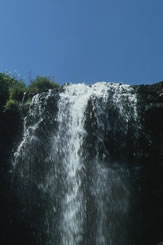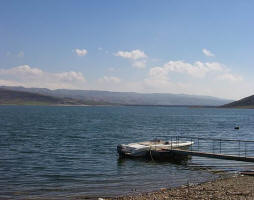 National Geographic on the plight of the Dead Sea
National Geographic on the plight of the Dead Sea
Posted from Tel Aviv by Sasha Richey, UCCHM Graduate Fellow. This is the third in a series of posts on our Water Diplomacy trip to Israel, Jordan and Palestine. Other posts in the series: 1) Middle East Lost a Dead Sea Amount of Water in 7 Years, by Jay Famiglietti ; and 2) Parallel Worlds: Water Management in Israel and California, by UCCHM Policy Fellow Kate Voss.
The Dead Sea sits in the heart of the world’s three main religions. According to the Torah, the Dead Sea was created by God in Sodom and its neighboring cities. It was where the Prophet Lot was sent for pilgrimage according to the Quran. The Dead Sea is fed by the waters that are said to have baptized Jesus Christ, the “mighty” Jordan River.
Despite the cultural, hydrological, historical, and socio-economic value of this unique water body, unsustainable use of the Jordan River and mining of its minerals continues to threaten the existence of the Dead Sea as it loses water at a rate of about one meter per year. However, the very project that is proposed to restore the sea has the potential to destroy it as well. TheUCCHM water diplomacy team attended the February 19, 2013 Multi-Stakeholder Consultation in Jerusalem on the proposed Red Sea-Dead Sea Water Conveyance program with the hope of learning more about the future of the project from stakeholders in Jordan, Israel, and the Palestinian Authority.
Overview of the Red Sea-Dead Sea Conveyance
There are three main objectives for the Red Sea-Dead Sea conveyance project: 1) to save the Dead Sea from environmental degradation; 2) to desalinate Red Sea water as a drinking water source for Amman, Jordan; and 3) to build a symbol of peace and cooperation between the three stakeholder entities. The “identified option” to meet these three goals is the “Red-Dead conduit,” which proposes to build a $10.6 billion dollar conveyance system to transfer saline water over 200 kilometers from the Red Sea north to the Dead Sea. The water would first be pumped up 250 meters from the Red Sea, and then would provide hydroelectricity as it travels down to the Dead Sea (elevation 423 meters below mean sea level). A desalination plant would be built by the Dead Sea to send freshwater up to Amman (elevation about 800 meters above mean sea level). The brine waste from desalination and extra seawater would be disposed of in the Dead Sea in order to restore and stabilize its water level.
The project was initially proposed by the Jordanian government, which then joined with Israel to present the concept to the World Bank. At that point, the World Bank required that the Palestinian Authority be added as a main stakeholder based on their riparian rights to the Dead Sea, which created a trilateral, cooperative project. Since then, the World Bank has acted in a management role to coordinate the project study efforts and to gain international support should the member countries choose to go forward with the project. The aim of the February 19, 2013 stakeholder meeting that we attended in Jerusalem was to present the key findings of the five initial studies conducted for the project, including a Feasibility Study and an Environmental and Social Assessment (ESA) Study, and to gain insight about the concerns and criticisms of leading civil society stakeholders in each country. Parallel consultations were held in Jordan and the Palestinian territories.
Based on the feedback from the public hearing and the five initial studies, it is not clear that adequate work has been done to fully understand the impacts of the “identified option.” The Feasibility Study reports that a minimum of 700 million cubic meters of additional water per year are necessary to stabilize the Dead Sea’s current water level, while more water will be needed to replenish it to historical levels. At about 400 million cubic meters per year of additional water, the amount of groundwater depletion in the surrounding area will stabilize.
The project managers proposed a pilot project to further explore the project’s feasibility and environmental impacts, but the pilot would only add up to 400 million cubic meters per year. It is exactly at this point that uncertainty is introduced in the ESA, whereby the environmental impacts of adding more than 400 million cubic meters of Red Sea water and brine to the Dead Sea are unknown.
According to Alex McPhail, the World Bank team leader on the project, there are only two other alternatives to the Red-Dead conduit that meet the three project objectives. The first is building a conveyance system from the Mediterranean to the Dead Sea for desalination. The second is a combination of desalination in the Gulf of Aqaba, water transfers from the Mediterranean, recycling and conservation, and water transfers from Turkey.
As our group’s recent paper on groundwater depletion trends from GRACE in the Tigris-Euphrates and Western Iran region shows, Turkey is losing large amounts of groundwater and surface water, and is therefore not a reliable water supply source. Prof. Jay Famiglietti made these comments during the open discussion period of the stakeholder meeting in Jerusalem (video to be uploaded shortly).
Stakeholder Perspectives and Water Management Challenges
The Red-Dead conduit epitomizes the global challenge of balancing water supply and demand between environmental, domestic, agricultural, and industrial needs. Our first impressions of the Red-Dead conduit have remained with us throughout our discussions with different stakeholders; it is an incredibly expensive project with dangerously little known about the environmental impact to the Dead Sea ecosystem.
It is not clear that this large infrastructure project would accurately represent the type of “peace project” that is described as a main project goal; nor will it provide environmental restoration to the Dead Sea beyond stabilizing its water level. However, our initial impressions have been challenged by the realities faced on the ground in relation to managing water scarcity, particularly in Jordan.
While in Amman, we met with the Secretary General Assistant of Technical Affairs in the Ministry of Water and Irrigation, Ali Subah. According to the Secretary General Assistant, the Jordanian government opposed the idea of a Red-Dead conduit 10 years ago, but has since been forced to change its position due to increasing water scarcity. Shuba told us, “Never put your soil in other hands with relation to water,” and that “without the Red-Dead project there is no way to keep water security in Jordan.”
He described an example of Jordan’s water challenges, with a reservoir that was constructed to capture water from the Yarmouk River. The reservoir was constructed with a capacity of about 110 million cubic meters, just half of the capacity recommended by scientists, anticipating the challenges that they would have with filling it. The reality was worse than planned, with a maximum volume of just 15 million cubic meters accumulated between 2007 to 2012. Upstream water use and climactic factors had severely reduced Jordan’s water supply to a small fraction of their legal allocation. The combination of population growth, an influx of Syrian refugees, and a limited economy based on mining, mineral extraction, and tourism are putting a huge strain on Jordan’s minimal natural resources. Jordan is looking for a big fix, and it now sees the Red-Dead conduit as its great hope for a sustainable water future.
In contrast, Friends of the Earth Middle East (FoEME), a non-profit organization that brings Israeli, Jordanian, and Palestinian environmentalists to work together, says the fix should come from restoring the Dead Sea’s source waters, the Jordan River. Munqeth Mehyar, the Jordanian Director of FoEME said the Red-Dead conduit, “would kill us,” from both an environmental perspective and the necessary reliance on foreign aid to fund the project.
At UCCHM, we agree that promoting conservation, efficiency, repairing of existing infrastructure, monitoring groundwater extraction and improved water pricing are among the best ways to begin restoring the Jordan River and the Dead Sea. Part of the goal of our trip here is to see how ourGRACE results and detailed water modeling can contribute to regional water management decisions, such as exploring the full environmental implications of mega-projects like the Red-Dead conduit, as well as comprehensive evaluation of its alternatives. However, there continues to be challenges to combine the best available science with political willpower for efficient water management decisions.
An Uncertain Future
The Red-Dead conduit project represents daunting challenges for water management in the Israel-Jordan-Palestinian Authority region. Although the specifics of the project are unique to this area, the broader challenge of balancing environmental preservation with a reliable water supply for human use is universal. For example, California already transfers large volumes of water over hundreds of kilometers in an effort to achieve this balance.
It is clear that there is no single solution, including the Red-Dead conduit, that will meet all water demands in a region. Lessons must be taken from places like New York City and its restoration of the Catskills Mountains, as a model to restore the Jordan River. Orange County’s ownGroundwater Replenishment System, which treats and reuses wastewater, is an example of a large infrastructure project that has the potential to be hugely successful in water-scarce regions. But, ecosystem restoration and infrastructure must be coupled with “small” fixes, such as repairing leaky pipes, implementing conservation and efficiency, and increasing transparency and communication between all end-users of shared water resources. This is a grand challenge in a region with the political and physical complexity of the Dead Sea basin, but a necessary one.
The future of the Red-Dead conduit remains uncertain. Political willpower, the need for environmental preservation, and a substantial amount of fundraising will dictate how priorities and resources are allocated. Moving forward, the project’s goals must be clear, whether the priority is to try to restore the Dead Sea first or to provide freshwater in Amman. As the project currently stands, these goals cannot be met in tandem. We hope that our work at UCCHM can provide a regional perspective for water transfers and management decisions, but ultimately the decision will come down to the key governmental and civil society stakeholders.
The striking similarities between, California and the United States and the Red-Dead conduitprovide a case study of the challenges for water management and large-scale water conveyance systems. The U. S. and other highly developed countries have made numerous environmental mistakes en route to developing the infrastructure required to maintain reliable water supplies to growing populations. Hopefully the Israel-Jordan-Palestinian Authority region can learn from these mistakes, and provide the world with a new model for combining ecosystem restoration with cooperative water management.
| Contact information | n/a |
|---|---|
| News type | Inbrief |
| File link |
http://newswatch.nationalgeographic.com/2013/03/04/desalinating-holy-waters-with-the-red-sea-dead-sea-conveyance/ |
| Source of information | Friends of the Earth Middle East (FoEME) |
| Subject(s) | ANALYSIS AND TESTS , CHARACTERISTICAL PARAMETERS OF WATERS AND SLUDGES , DRINKING WATER , DRINKING WATER AND SANITATION : COMMON PROCESSES OF PURIFICATION AND TREATMENT , ENERGY , FINANCE-ECONOMY , HYDRAULICS - HYDROLOGY , INDUSTRY , INFORMATION - COMPUTER SCIENCES , INFRASTRUCTURES , MEASUREMENTS AND INSTRUMENTATION , METHTODOLOGY - STATISTICS - DECISION AID , NATURAL MEDIUM , POLICY-WATER POLICY AND WATER MANAGEMENT , PREVENTION AND NUISANCES POLLUTION , RIGHT , RISKS AND CLIMATOLOGY , SANITATION -STRICT PURIFICATION PROCESSES , SLUDGES , TOURISM - SPORT - HOBBIES , WATER DEMAND , WATER QUALITY |
| Relation | http://www.emwis.net/thematicdirs/news/2013/02/comments-ecopeace-foeme-world-bank-public-hearing-concerning-red-dead-conduit |
| Geographical coverage | Jordan,Israel,Palestine, |
| News date | 12/03/2013 |
| Working language(s) | ENGLISH |
 you are not logged in
you are not logged in





